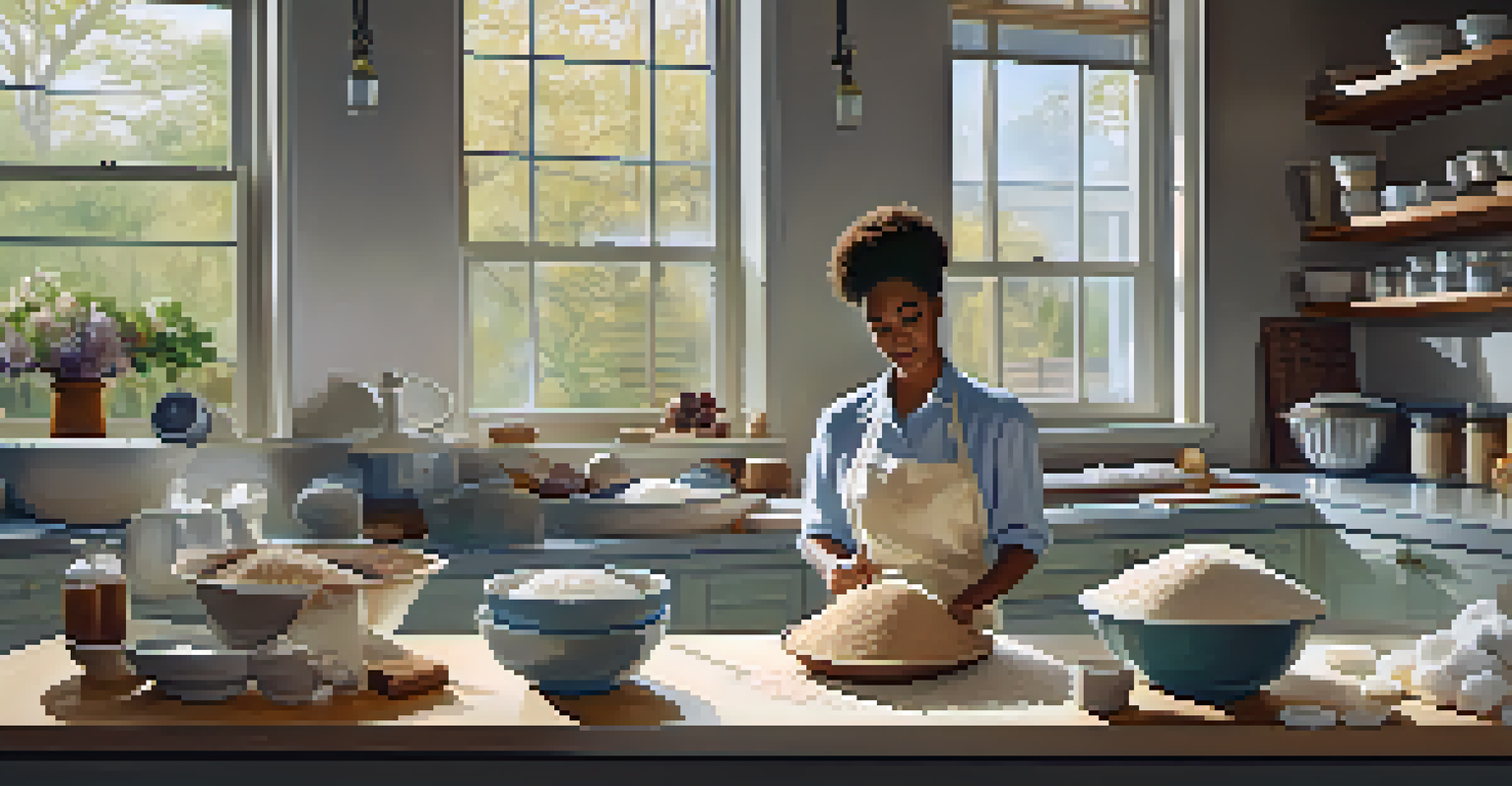The Journey of Sugar: Historical Recipes and Their Impact

The Origins of Sugar: From Plant to Palette
Sugar's journey begins with the sugarcane plant, cultivated for thousands of years. Initially native to Southeast Asia, it spread to India and the Mediterranean, becoming a sought-after commodity. The process of extracting sugar from cane was labor-intensive, yet the sweet reward was irresistible, leading to its rise in popularity across different cultures.
Sugar is the ultimate truth serum.
As sugar made its way to Europe in the Middle Ages, it transformed from a luxury item to a staple in kitchens. It was used in everything from medicinal concoctions to lavish desserts, showcasing its versatility. The introduction of sugar into various recipes not only satisfied sweet cravings but also boosted local economies as trade flourished.
Throughout history, sugar has been more than just an ingredient; it has been a symbol of wealth and status. Its presence in royal banquets and festive celebrations highlighted its significance in society, setting the stage for its pivotal role in culinary traditions around the world.
Sweetening Up History: Sugar in Ancient Civilizations
Ancient civilizations recognized sugar's potential long before it became a global sensation. The Sumerians, for instance, used honey as a sweetener in their recipes, while the Egyptians harnessed the sweetness of sugarcane to create delectable treats. These early uses laid the groundwork for sugar's future culinary applications.

In India, the extraction of sugar from cane led to the invention of jaggery, a traditional sweetener still popular today. This method not only preserved the sweetness but also made it accessible to a broader populace. As sugar spread through trade routes, it began to influence cuisines far beyond its origins.
Sugar's Complex Historical Journey
Sugar has evolved from a luxury item in ancient civilizations to a staple ingredient, intertwined with cultural practices and historical events.
The Romans, too, played a significant role in sugar's history, although they primarily used honey. However, their conquests introduced sugarcane to new territories, further embedding it in various culinary practices. This cross-cultural exchange made sugar an integral part of many ancient recipes.
The Sweet Renaissance: Sugar in Medieval Europe
The Renaissance marked a turning point for sugar in Europe, as it started to appear in more diverse recipes. Sweet dishes began to complement savory ones, leading to innovative culinary creations. Sugar was no longer just an exotic spice; it became a key ingredient in pastries, cakes, and confections.
There is no love sincerer than the love of food.
As sugar became more affordable, it found its way into households across social classes. Recipes evolved, reflecting regional flavors and ingredients, and soon, desserts like marzipan and gingerbread dominated the scene. This era saw the birth of baking as a popular pastime, solidifying sugar's place in European culture.
Moreover, sugar's role in preserving fruits and making jams expanded its culinary footprint. This not only catered to the sweet tooth but also helped in food preservation techniques, showcasing sugar's multifaceted utility in the kitchen. The medieval love affair with sugar set the stage for future culinary innovations.
Colonialism and Sugar: A Bitter History
While sugar sweetened many dishes, its journey was not without dark chapters. The demand for sugar in Europe led to the establishment of plantations in the Americas, relying heavily on enslaved labor. This grim reality highlights the moral complexities intertwined with sugar's rise in popularity.
The sugar trade became a driving force in the transatlantic slave trade, creating devastating impacts on African communities. This exploitation shaped the economies of colonial powers and created a legacy of inequality that still resonates today. Understanding this history is crucial to appreciating sugar's place in our culinary landscape.
Culinary Innovations with Sugar
Modern bakers are creatively experimenting with various types of sugar, blending traditional recipes with innovative techniques to enhance flavors and textures.
Despite its troubling past, sugar's influence on food culture expanded significantly. It inspired new recipes, brought diverse flavors to the table, and created a fusion of culinary traditions that enriched global cuisines. Acknowledging this history allows us to appreciate sugar's role while fostering a more conscious approach to its consumption.
Modern Recipes: Celebrating Sugar's Sweet Legacy
Today, sugar remains a beloved ingredient in countless recipes worldwide, from classic desserts to contemporary treats. Modern bakers experiment with various sugars, including brown sugar, powdered sugar, and even alternatives like coconut sugar. Each type brings its unique flavor and texture to dishes, allowing for creativity in the kitchen.
Culinary traditions have evolved, with many chefs blending traditional recipes with innovative techniques. For instance, the rise of artisanal baking has reignited interest in historical recipes that showcase sugar's versatility. Desserts like soufflés and macarons highlight sugar's critical role in achieving the perfect texture and flavor.
Moreover, the health consciousness of today's society has led to a reevaluation of sugar's role in our diets. While some opt for reduced sugar or sugar substitutes, others embrace moderation and celebrate the joy of sweetness in their meals. This ongoing dialogue reflects our complex relationship with sugar and its impact on our culinary experiences.
Cultural Significance: Sugar in Global Celebrations
Sugar's journey is also marked by its cultural significance in celebrations around the world. From wedding cakes to festive treats, sugar often plays a central role in marking special occasions. Different cultures have unique ways of incorporating sugar into their traditions, showcasing its universal appeal.
For instance, in many Latin American countries, sugar is integral to festivities like Día de los Muertos, where sugar skulls symbolize remembrance and celebration. In Asia, sweet dumplings are a staple during Lunar New Year, representing family unity and prosperity. These customs illustrate how sugar transcends mere sweetness to embody deeper meanings.
Future Trends in Sugar Consumption
With a growing focus on health and sustainability, the sugar industry is adapting through innovations in alternatives and ethically sourced products.
As we gather to celebrate life's milestones, sugar often takes center stage, reminding us of the connections we share through food. Whether it's a birthday cake or holiday cookies, these sweet treats become part of our collective memory, enriching the tapestry of human experience. Sugar, in all its forms, continues to unite people across cultures.
The Future of Sugar: Trends and Innovations
As we look to the future, the conversation around sugar is evolving. With growing awareness of health implications, many are seeking healthier alternatives without sacrificing flavor. Innovations in sugar substitutes, such as stevia and monk fruit, are gaining traction, offering options for those with dietary restrictions.
Additionally, sustainability is becoming increasingly important in the sugar industry. Consumers are looking for ethically sourced products that support fair trade practices. This shift encourages brands to prioritize transparency and environmental responsibility, reflecting a broader trend towards mindful eating.

Ultimately, the future of sugar is about balance. While it's essential to enjoy the sweetness in our lives, being conscious of its impact on health and society is equally vital. By embracing innovation and sustainability, we can ensure that sugar continues to play a positive role in our culinary journeys.